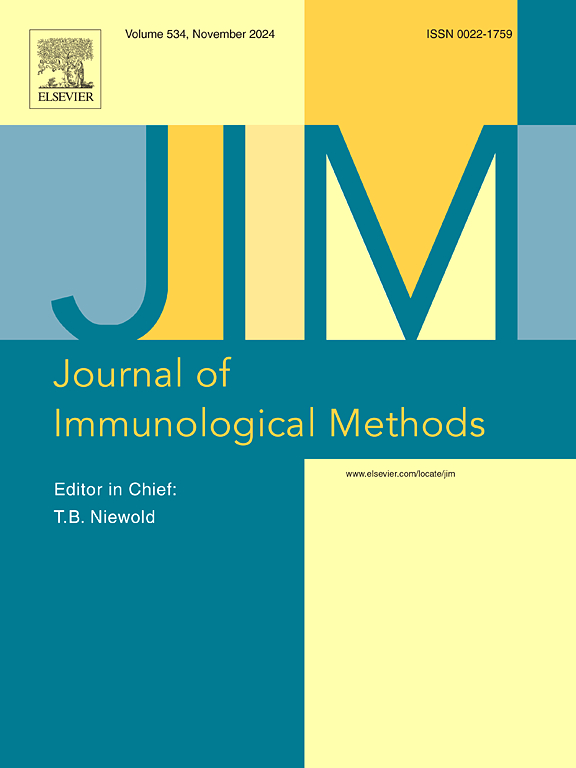Development of sandwich enzyme-linked immunosorbent assays quantifying mouse urinary megalin, a novel proximal tubular biomarker
IF 1.6
4区 医学
Q4 BIOCHEMICAL RESEARCH METHODS
引用次数: 0
Abstract
Megalin, a type I transmembrane protein, serves as a multi-ligand endocytic receptor in the apical membrane of proximal tubules. Its ectodomain and full-length forms are excreted into human urine, with the former being more abundant. We previously developed two types of sandwich enzyme-linked immunosorbent assays (ELISAs) utilizing monoclonal antibodies that target the amino-terminal ligand-binding domain-I and the carboxyl-terminal cytoplasmic region of human megalin, respectively. The former, termed “A-megalin” ELISA, primarily identifies ectodomains of megalin, whereas the latter, “C-megalin” ELISA, specifically recognizes full-length megalin originating from urinary extracellular vesicles. This study developed novel sandwich ELISAs to assess mouse urinary A-megalin and C-megalin, thereby facilitating studies involving these biomarkers in mouse disease models. Immunoblotting and immunohistochemistry of monoclonal antibodies against human megalin were performed to assess their compatibility with mouse megalin in novel sandwich ELISAs, which were constructed and validated using human assay protocols. Immunoblot analysis of megalin in urinary extracellular vesicles and supernatant was performed to investigate the ratio of ectodomain to full-length forms in mouse urine. Stable measurements having a precision and accuracy within 15 % were achieved in the measurement of quality control samples. A-megalin and C-megalin were detectable in the urine of C57BL/6 mice, whereas most urine samples from kidney-specific conditional megalin-knockout mice were below detection limits. Ectodomain forms of megalin were at least approximately 70 times more abundant than the full-length form, even in mouse urine. In conclusion, we successfully developed sandwich ELISAs for assessing mouse urinary A-megalin and C-megalin to evaluate primarily ectodomain and full-length forms of megalin, respectively.
开发夹心酶联免疫吸附测定法,定量检测小鼠尿巨蛋白--一种新型近端肾小管生物标记物。
Megalin 是一种 I 型跨膜蛋白,是近端肾小管顶端膜上的多配体内细胞受体。它的外结构域和全长形式都会排入人体尿液,其中前者的含量更高。我们以前开发了两种夹心酶联免疫吸附试验(ELISA),利用的单克隆抗体分别针对人巨球蛋白的氨基末端配体结合域-I和羧基末端胞浆区。前者称为 "A-megalin "ELISA,主要识别megalin的外结构域,而后者称为 "C-megalin "ELISA,专门识别来自尿液细胞外囊泡的全长megalin。这项研究开发了新型夹心酶联免疫吸附测定法来评估小鼠尿液中的A-megalin和C-megalin,从而促进了涉及小鼠疾病模型中这些生物标志物的研究。针对人巨球蛋白的单克隆抗体进行了免疫印迹和免疫组织化学分析,以评估它们与小鼠巨球蛋白在新型夹心酶联免疫吸附试验中的兼容性。对小鼠尿液细胞外囊泡和上清液中的galin进行了免疫印迹分析,以研究小鼠尿液中异构体和全长形式的比例。在对质量控制样本进行测量时,获得了精确度和准确度均在 15% 以内的稳定测量结果。在 C57BL/6 小鼠的尿液中可检测到 A-megalin 和 C-megalin,而肾脏特异性条件性megalin基因敲除小鼠的尿液样本大多低于检测限。即使在小鼠尿液中,megalin 的外结构域形式的含量也至少是全长形式的约 70 倍。总之,我们成功地开发了夹心酶联免疫吸附测定法,用于评估小鼠尿液中的A-megalin和C-megalin,分别主要评估egotodomain和全长形式的megalin。
本文章由计算机程序翻译,如有差异,请以英文原文为准。
求助全文
约1分钟内获得全文
求助全文
来源期刊
CiteScore
4.10
自引率
0.00%
发文量
120
审稿时长
3 months
期刊介绍:
The Journal of Immunological Methods is devoted to covering techniques for: (1) Quantitating and detecting antibodies and/or antigens. (2) Purifying immunoglobulins, lymphokines and other molecules of the immune system. (3) Isolating antigens and other substances important in immunological processes. (4) Labelling antigens and antibodies. (5) Localizing antigens and/or antibodies in tissues and cells. (6) Detecting, and fractionating immunocompetent cells. (7) Assaying for cellular immunity. (8) Documenting cell-cell interactions. (9) Initiating immunity and unresponsiveness. (10) Transplanting tissues. (11) Studying items closely related to immunity such as complement, reticuloendothelial system and others. (12) Molecular techniques for studying immune cells and their receptors. (13) Imaging of the immune system. (14) Methods for production or their fragments in eukaryotic and prokaryotic cells.
In addition the journal will publish articles on novel methods for analysing the organization, structure and expression of genes for immunologically important molecules such as immunoglobulins, T cell receptors and accessory molecules involved in antigen recognition, processing and presentation. Submitted full length manuscripts should describe new methods of broad applicability to immunology and not simply the application of an established method to a particular substance - although papers describing such applications may be considered for publication as a short Technical Note. Review articles will also be published by the Journal of Immunological Methods. In general these manuscripts are by solicitation however anyone interested in submitting a review can contact the Reviews Editor and provide an outline of the proposed review.

 求助内容:
求助内容: 应助结果提醒方式:
应助结果提醒方式:


